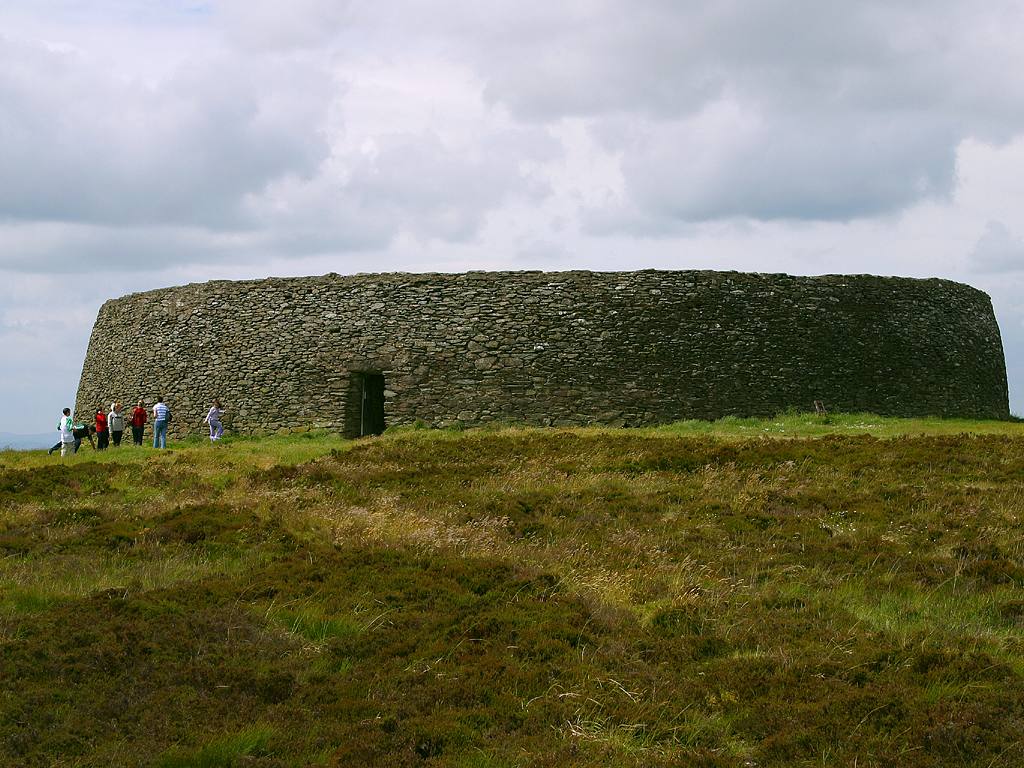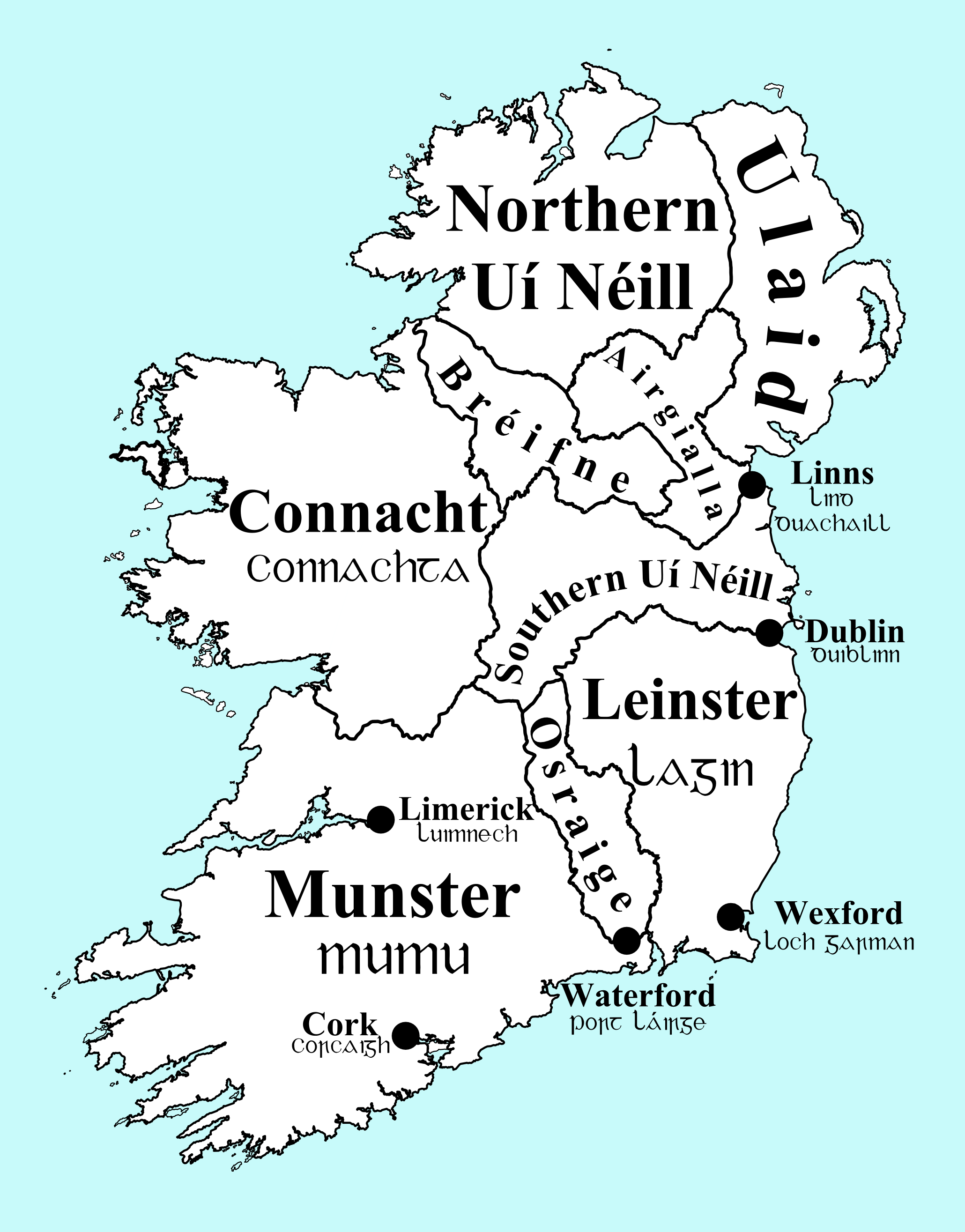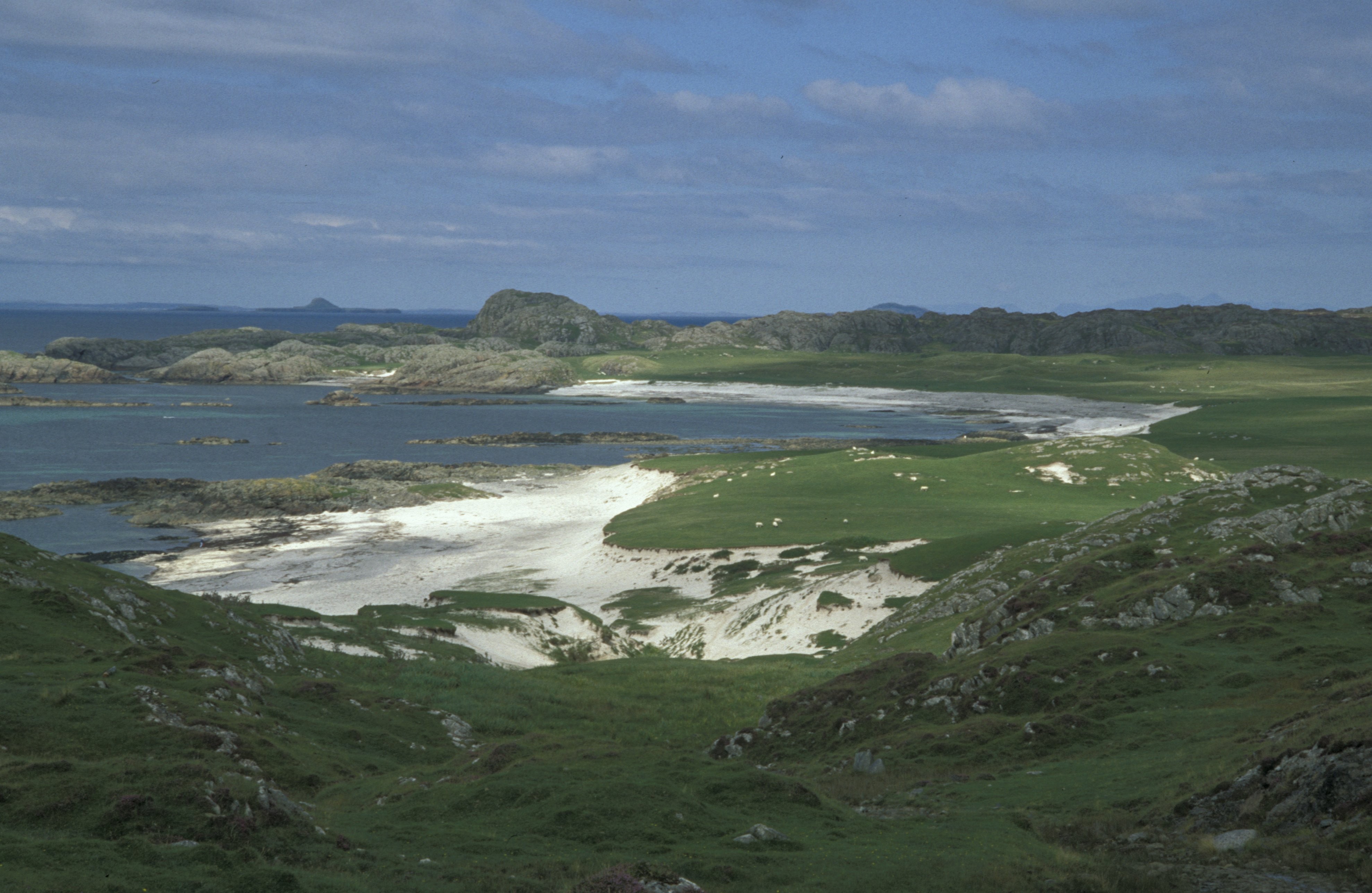|
Drumcliff Monastery, County Sligo
Drumcliff Monastery () was located in Cairbre Drom Cliabh, now County Sligo, five miles north of the modern town of Sligo. The site consists of the remains of a round tower and several high crosses, including one outstanding example. It is currently also the site of a Church of Ireland parish church and a graveyard. It is the burial place of the poet William Butler Yeats. Founded in the 6th century by Saint Colmcille, he is said to have declared in a later literary fragment: Beloved to my heart also in the West— Drumcliffe at Culcinne's strand. Location Drumcliff was founded as a monastery in 574 AD, at the base of Benbulben by Saint Colmcille in the territory of Cairbre Drom Cliabh, an area ruled by the Cinel Cairbre descendants of Cairbre Mac Neill son of Niall of the Nine Hostages the founder of the Ui Neill dynasty. The site was probably donated by the northern Ui Neill High king and relative of Colmcille, Aed Ainmire. The monastery was located on the south ba ... [...More Info...] [...Related Items...] OR: [Wikipedia] [Google] [Baidu] |
Sligo
Sligo ( ; , meaning 'abounding in shells') is a coastal seaport and the county town of County Sligo, Ireland, within the western province of Connacht. With a population of 20,608 in 2022, it is the county's largest urban centre (constituting 29.5% of the county's population) and the List of urban areas in the Republic of Ireland, 24th largest in the Republic of Ireland. Sligo is a commercial and cultural centre situated on the west coast of Ireland. Its surrounding coast and countryside, as well as its connections to the poet W. B. Yeats, have made it a tourist destination. History Etymology Sligo is the anglicisation of the Irish name ''Sligeach'', meaning "abounding in shells" or "shelly place". It refers to the abundance of shellfish found in the river and its estuary, and from the extensive shell middens in the vicinity. The river now known as the River Garavogue, Garavogue (), perhaps meaning "little torrent", was originally called the Sligeach. It is listed as one of ... [...More Info...] [...Related Items...] OR: [Wikipedia] [Google] [Baidu] |
Termonn
is a Gaelic (Irish) word meaning 'sanctuary, boundary'. Other spellings include '','' and . It denotes land belonging to Irish early Christian monasteries and churches on which right of sanctuary prevailed. The word is common in many place names in Ireland. Etymology It is derived from Latin Latin ( or ) is a classical language belonging to the Italic languages, Italic branch of the Indo-European languages. Latin was originally spoken by the Latins (Italic tribe), Latins in Latium (now known as Lazio), the lower Tiber area aroun ... meaning 'goal, end point or boundary'. In ancient Rome, Terminus was the name of the deity who presided over boundaries and landmarks. The placement of ''s'' in the Irish landscape suggests they were also associated with transit at boundaries across rivers and bays. Cattle and other moveable forms of wealth were often gathered in them, as mentions of raids on ''s'' attest. ''s'' were often marked by stone boundary markers. A famous ex ... [...More Info...] [...Related Items...] OR: [Wikipedia] [Google] [Baidu] |
Erenagh
The medieval Irish office of erenagh (Old Irish: ''airchinnech'', Modern Irish: ''airchinneach'', Latin: '' princeps'') was responsible for receiving parish revenue from tithes and rents, building and maintaining church property and overseeing the termonn lands that generated parish income. Thus he had a prebendary A prebendary is a member of the Catholic Church, Catholic or Anglicanism , Anglican clergy, a form of canon (priest) , canon with a role in the administration of a cathedral or collegiate church. When attending services, prebendaries sit in part ... role. The erenagh originally had a tonsure but took no other holy orders; he had a voice in the Chapter when they consulted about revenues, paid a yearly rent to the Bishop and a fine on the marriage of each daughter. The role usually passed down from generation to generation in certain families in each parish. After the Reformation and the Dissolution of the Monasteries the role of erenagh became subsumed in the res ... [...More Info...] [...Related Items...] OR: [Wikipedia] [Google] [Baidu] |
Coarb
A coarb, from the Old Irish ''comarbae'' (Modern Irish: , ), meaning "heir" or "successor", was a distinctive office of the medieval Celtic Church among the Gaels of Ireland and Scotland. In this period coarb appears interchangeable with " erenach", denoting the episcopally nominated lay guardian of a parish church and headman of the family in hereditary occupation of church lands. The coarb, however, often had charge of a church which had held comparatively high rank in pre‐Norman Ireland, or one still possessed of relatively extensive termon lands. Also as per this article "... such lucrative monastic offices as “coarb” (comarbae “heir” to a saint) or “ erenach” (airchinnech “superior”), otherwise transmitted by natural or nepotic descent within ecclesiastical families, which were often the politically displaced branches of royal dynasties" The current chief of Clan Livingstone in Scotland was recognised by Lord Lyon as the "Coarb of Saint Moluag" and the "He ... [...More Info...] [...Related Items...] OR: [Wikipedia] [Google] [Baidu] |
Culdees
The Culdees (; ) were members of ascetic Christian monastic and eremitical communities of Ireland, Scotland, Wales and England in the Middle Ages. Appearing first in Ireland and then in Scotland, subsequently attached to cathedral or collegiate churches; they lived in monastic fashion though not taking monastic vows.D'Alton, Edward Alfred (1908). " Culdees". In ''Catholic Encyclopedia''. 4. New York: Robert Appleton Company. Etymology According to the Swiss theologian Philip Schaff, the term Culdee or Ceile De, or Kaledei, first appeared in the 8th century. While "giving rise to much controversy and untenable theories", it probably means servants or worshippers of God. The term was applied to anchorites, who, in entire seclusion from society, sought the perfection of sanctity through their values of poverty, charity, self-denial and perseverance. They afterward associated themselves into communities of hermits and were finally brought under canonical rule along with the secular ... [...More Info...] [...Related Items...] OR: [Wikipedia] [Google] [Baidu] |
Áed Oirdnide
Áed mac Néill (; died 819), commonly called Áed Oirdnide ("the anointed"), was King of Ailech. A member of the Cenél nEógain dynasty of the northern Uí Néill, he was the son of Niall Frossach. Like his father, Áed was reckoned High King of Ireland. He was King of Ailech from 788 onwards and High King of Ireland from 797. King of Ailech The conflict between Cenél nEógain and Cenél Conaill for the leading role in the north appears to have turned on control over the lands of the minor Cenél nEndai branch of the Uí Néill which lay around Raphoe. Communications between the northern and southern branches of Cenél Conaill, respectively based on the north-west coast of Donergal and in the south around Donegal town, ran through these. While Cenél nEndai were clients or allies of Cenél Conaill, as they had been before Áed Allán defeated Flaithbertach mac Loingsig in the 730s, Cenél Conaill had the upper hand, and provided kings of Tara and kings of the North. By the ... [...More Info...] [...Related Items...] OR: [Wikipedia] [Google] [Baidu] |
Cenél NEogain
Cenél is a surname. Notable people with the surname include: *Cenél Conaill, the name of the "kindred" or descendants of Conall Gulban, son of Niall Noígiallach defined by oral and recorded history *Cenél nEógain (in English, Cenel Eogan) is the name of the "kindred" or descendants of Eógan mac Néill, son of Niall Noígiallach who founded the kingdom of Tír Eógain in the 5th century *Kin groups forming part of Dal Riata, most of which, after a varied evolution eventually became the Scottish region of Argyll **Cenél nÓengusa, a kin group who ruled the island of Islay, and perhaps nearby Colonsay. After spending 4 centuries as part of Norway, and another 4 as part of the quasi-independent Lordship of the Isles, this region became Scottish in the late 15th century. ** Cenél nGabráin, the "kindred" of Gabrán, who ruled Kintyre, Knapdale (at that time including the lands between Loch Awe and Loch Fyne - Craignish, Ardscotnish, Glassary, and Glenary), the island of Arr ... [...More Info...] [...Related Items...] OR: [Wikipedia] [Google] [Baidu] |
Clann Cholmáin
Clann Cholmáin is the dynasty descended from Colmán Már mac Diarmato, son of Diarmait mac Cerbaill. Part of the Southern Uí Néill — they were the kings of Mide (Meath) — they traced their descent to Niall Noígiallach and his son Conall Cremthainne. Related dynasties descended through Conall Cremthainne and Diarmait mac Cerbaill included the Síl nÁedo Sláine, the kings of Brega, descended from Colmán Már's youngest brother Áed Sláine, and the less important Clann Cholmáin Bicc (or the Caílle Follamain), descendants of the middle brother, Colmán Bec. The Kings of Uisnech, among others, belonged to Clann Cholmáin. Important kings of Clann Cholmáin include: * Domnall Midi (died 763), * Donnchad Midi mac Domnaill (died 797), * Máel Sechnaill mac Maíl Ruanaid (died 862), * Flann Sinna (died 916), * Máel Sechnaill mac Domnaill (died 1022). Bibliography * Byrne, Francis John, ''Irish Kings and High-Kings.'' Batsford, London, 1973. * '' ... [...More Info...] [...Related Items...] OR: [Wikipedia] [Google] [Baidu] |
Southern Uí Néill
The Southern Uí Néill (, ) were a branch of the Uí Néill dynasty that invaded and settled in the Kingdom of Mide and its associated kingdoms. Two sons of Niall Noigiallach, Lóegaire () and Coirpre (), initially led the dynasty. As did their immediate descendants. However, after the murder of Túathal Máelgarb in about 544, it was left to another branch of the family descended from another of Niall's sons – Conall Cremthainne – to continue Uí Néill expansion and consolidate their position. No descendants of either Lugaid mac Lóegairi or Túathal Máelgarb are recorded. Just as their kinsmen the Northern Uí Néill split into two main branches, so too did the Southern Uí Néill, both being descended from sons of Diarmait mac Cerbaill, Colmán Már and Áed Sláine. The former was the progenitor of the Clann Cholmáin, while the latter was the eponymous ancestor of the Síl nÁedo Sláine. Clann Cholmáin ruled the kingdom of Mide, while Síl nÁedo Sláine ... [...More Info...] [...Related Items...] OR: [Wikipedia] [Google] [Baidu] |
Cenél Conaill
Cenél is a surname. Notable people with the surname include: *Cenél Conaill, the name of the "kindred" or descendants of Conall Gulban, son of Niall Noígiallach defined by oral and recorded history *Cenél nEógain (in English, Cenel Eogan) is the name of the "kindred" or descendants of Eógan mac Néill, son of Niall Noígiallach who founded the kingdom of Tír Eógain in the 5th century *Kin groups forming part of Dal Riata, most of which, after a varied evolution eventually became the Scottish region of Argyll **Cenél nÓengusa, a kin group who ruled the island of Islay, and perhaps nearby Colonsay. After spending 4 centuries Scandinavian Scotland, as part of Norway, and another 4 as part of the quasi-independent Lord of the Isles, Lordship of the Isles, this region became Scottish in the late 15th century. ** Cenél nGabráin, the "kindred" of Gabrán, who ruled Kintyre, Knapdale (at that time including the lands between Loch Awe and Loch Fyne - Craignish, Ardscotnish, River ... [...More Info...] [...Related Items...] OR: [Wikipedia] [Google] [Baidu] |
Iona
Iona (; , sometimes simply ''Ì'') is an island in the Inner Hebrides, off the Ross of Mull on the western coast of Scotland. It is mainly known for Iona Abbey, though there are other buildings on the island. Iona Abbey was a centre of Gaelic monasticism for three centuries and is today known for its relative tranquility and natural environment. It is a tourist destination and a place for spiritual retreats. Its modern Scottish Gaelic name means "Iona of (Saint) Columba" (formerly anglicised as "Icolmkill"). In 2019, Iona's estimated population was 120. In March 1980, the Hugh Fraser Foundation donated much of the main island (and its off-lying islands) to the current owner, the National Trust for Scotland. The abbey and some church buildings are owned by the Iona Cathedral Trust. One publication, describing the religious significance of the island, says that the island is "known as the birthplace of Celtic Christianity in Scotland,” and notes that “St Columba came here ... [...More Info...] [...Related Items...] OR: [Wikipedia] [Google] [Baidu] |




